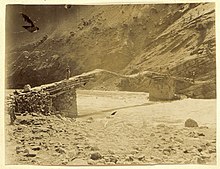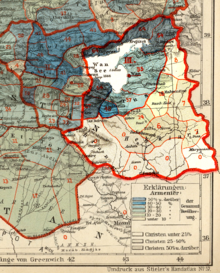Hakkari (historical region)
Hakkari (

History


The region stretching from
In 980AD, 'Adud Al-Dawla sent an expedition against Hakkari Kurds and subdued them.[2] In 1041AD, after the defeat of the invading Ghuz turks and subsequent massacre in Urmia by Rawadids. They fled to Hakkari where they ravaged it. they were eventually defeated by the Kurds and 1500 Ghuz tribesmen were killed and the survivors were enslaved by the Kurds.[3][4]
Following the devastation of the urban centres of Mesopotamia at the hands of
By the 1500s, the Assyrians were concentrated in an older version of the Assyrian triangle, with its points in
The Patriarch residing in the Church of Mār Shalīṭa in Qudshanis enjoyed both spiritual and political power over his subjects. Since priests were required to remain celibates the patriarchy moved from uncle to nephew.[5] This system came to be known as Nāṭar Kursyā (ܢܛܪ ܟܘܪܣܝܐ "Guardian of the throne"), and by the 19th century this system was applied to all dioceses of Hakkari.[6] The Assyrians formed intricate alliances with neighbouring Kurdish tribes and their Ottoman lords, and each tribe was led by a Malik (ܡܠܟ) who also functioned as a military leader during wartime.[7]
Kurdish wars
In the 19th century, several competing Kurdish centers began emerging in the region.
After the fall of his main rival
Direct Ottoman control

Although the region was nominally under
Genocide and exodus
On the eve of the First World War, patriarch
The turning point was when the patriarch's brother was taken prisoner as he was studying in Constantinople. The Ottomans demanded Assyrian neutrality and executed him as a warning.[17][18] In return, the patriarch declared war on the Ottomans on 10 April 1915.[17]
The Assyrians were immediately attacked by Kurdish irregulars backed by the Ottomans, driving most of the Assyrians of Hakkari to the mountain tops, as those who stayed in their villages were killed.
After the First World War
During the peace conferences in Paris in 1919, the Assyrians asked for a state in
Economy
As of 1920, Hakkari was producing lead. The lead, which came from a government owned mine, was used to make bullets.[21]
See also
- List of Assyrian tribes
- Tyari
- Barwari
- Shemsdin (East Syriac ecclesiastical province)
- Assyrian homeland
Notes
- ^ Aboona 2008, p. 2
- ^ Houtsma, M. Th (1993). E. J. Brill's First Encyclopaedia of Islam, 1913-1936. BRILL. p. 1137. ISBN 978-90-04-09790-2.
- ^ Peacock, Andrew (2017). "Rawwadids". Encyclopædia Iranica, online edition. New York.
- ISBN 978-90-04-09790-2.
- ^ a b Alexander 1994, p. 36
- ^ Wilmshurst 2000, p. 277
- ^ Aboona 2008, p. 35
- ^ Aboona 2008, p. 173
- ^ Aboona 2008, p. 174
- ^ Aboona 2008, p. 179
- ^ a b c McDowall 2000, p. 47
- ^ Aboona 2008, p. 3
- ^ Stafford 2006, p. 23
- ^ Stafford 2006, p. 24
- ^ Gaunt & Beṯ-Şawoce 2006, p. 134
- ^ Gaunt & Beṯ-Şawoce 2006, p. 136
- ^ a b c d e f Stafford 2006, p. 25
- ^ Yusuf, Malik. "The Assyrian Tragedy". www.aina.org. Archived from the original on October 10, 2018. Retrieved May 20, 2020.
- ^ Nisan 2002, p. 187
- ^ Nisan 2002, p. 188
- ^ Prothero, W. G. (1920). Armenia and Kurdistan. London: H.M. Stationery Office. p. 71. Archived from the original on December 21, 2020. Retrieved September 18, 2013.
References
- ISBN 978-1-60497-583-3.
- Alexander, V (1994) [1994], The First Civilization, Victor Alexander, ISBN 978-1-4486-7089-5.
- Chevalier, Michel (1985). Les montagnards chrétiens du Hakkâri et du Kurdistan septentrional (in French). Dép. de géographie de l'Université de Paris-Sorbonne. ISBN 978-2-901165-13-2.
- ISBN 978-1-59333-301-0.
- McDowall, D (2000), A modern history of the Kurds, I.B. Tauris, ISBN 978-1-85043-416-0.
- ISBN 978-0-7864-1375-1.
- Stafford, R (2006) [1935], The Tragedy of the Assyrians, Gorgias Press, ISBN 978-1-59333-413-0.
- ISBN 978-90-429-0876-5.
